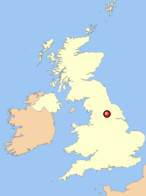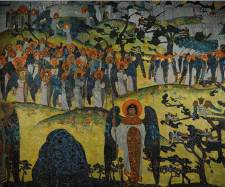
Location of the Harogate Area in the UK
Viking hoard discovered in the Harrogate area Most important Viking Treasure in 150 years found by metal detectorists in North Yorkshire ]]>
July 30th 2007, source: The British Museum
A major Viking hoard was discovered in the Harrogate area in January 2007 by metal-detectorists David and Andrew Whelan. The size and quality of the hoard is remarkable, making it the most important find of its type in Britain for over 150 years.
The hoard contains a total of 617 silver coins and 65 other objects, as well as a gold-arm-ring and the gilt silver vessel. Several fragments of lead found with the hoard appear to come from some sort of container.
The most spectacular single object is a gilt silver vessel, made in what is now France in the first half of the ninth century. It was apparently intended for use in church services, and was probably either looted from a monastery by Vikings, or given to them in tribute. Most of the smaller objects were hidden inside this vessel, which was itself protected by some form of lead container. As a result, the hoard was extremely well-preserved. Other star objects include a rare gold arm-ring, and over 600 coins, including several new or rare types. These provide valuable new information about the history of England in the early tenth century, as well as Yorkshire’s wider cultural contacts in the period. Interestingly, the hoard contains coins relating to Islam and to the pre-Christian religion of the Vikings, as well as to Christianity.
The hoard was probably buried for safety by a wealthy Viking leader during the unrest that followed the conquest of the Viking kingdom of Northumbria in AD 927 by the Anglo-Saxon king Athelstan (924-39).
The Harrogate hoard was declared to be Treasure under the terms of the Treasure Act (1996) by Mr Fell, HM Coroner for North Yorkshire, on 19 July 2007. The find is of global importance, as well as having huge significance for the history of North Yorkshire. York Museum Trust, Harrogate Borough Council’s Museums & Arts Service and the British Museum are committed to working together to acquire, interpret and exhibit the hoard, and to making it accessible to the widest possible public, both in the region and elsewhere.
The next stage of the Treasure process is for the hoard to be valued for the Department of Culture, Media and Sport by the independent Treasure Valuation Committee. In the meantime the museums will continue to develop more detailed plans to raise money for the acquisition, and to exhibit the hoard once it is acquired.
Margaret Hodge, Culture Minister said: “Finds such as this are invaluable in teaching us about our history. This remarkable discovery highlights the contribution both the Treasure Act and the Portable Antiquities Scheme continue to make towards our knowledge of the past. I commend David and Andrew Whelan for their prompt and responsible reporting of this hugely significant find, which will enrich our understanding of the Vikings.”
Mr Fell, Coroner, commented: ‘Treasure cases are always interesting, but this is one of the most exciting cases that I have ever had to rule on. I’m delighted that such an important Viking hoard has been discovered in North Yorkshire. We are extremely proud of our Viking heritage in this area.
Mary Kershaw, Director of Collections at York, said: ‘York’s new partnership with the British Museum has focused on sharing collections for display, such as the Warren Cup and Roman collections for the Constantine exhibition at the Yorkshire Museum. It would be wonderful to work together on the joint purchase of such a stunning and important group of material.’
Gina Lane Director of Operations, Museums, Libraries and Archives Council said: “Thanks to the continuing responsible behaviour of metal detectorists, another fantastic find has been made available for everyone to enjoy, either online or in museums. This is also thanks to successful partnership working between the local museum services and the British Museum.”
Follow us on:

